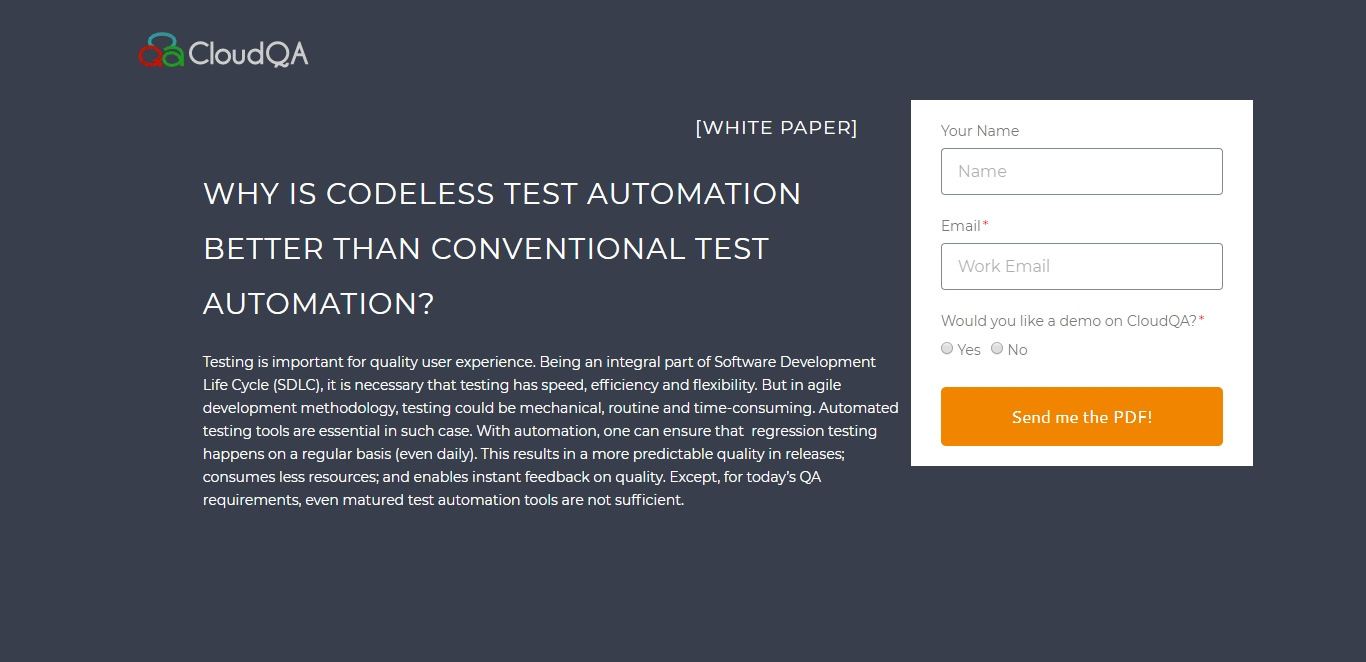Dynatrace vs CloudQA Synthetic Monitoring Tools Comparison
HubSpot claims, if the site brings in $100,000 / day in revenues, 1 sec page improvement will bring in extra $7,000. That’s how much a second is worth; it can mean a 7% increase or decrease in your revenues.

Dynatrace – Synthetic Monitoring:
Short synopsis: Dynatrace is an Application Performance Management (APM) software that runs for on-premise and cloud applications. Dynatrace – Synthetic Monitoring is one of its performance analysis tools.
How does it work: Record and playback tool for creation of monitoring scenarios.
Standout features: Monitoring for multiple locations in a single execution.
Challenges: Basic record and playback tool to build monitoring scenarios.
Pros: Global coverage, rich dashboard and detailed reporting.
Cons: Doesn’t work on complex web applications like Single Page Application, no provision to edit a scenario after being created and high costs.
Bottomline: Dynatrace – Synthetic Monitoring tool is useful ONLY for very basic monitoring and can be very costly to operate.
CloudQA TruMonitor:
Short synopsis: CloudQA is a cloud based web testing and performance analysis platform. TruMonitor is a synthetic monitoring tool by CloudQA.
How does it work: Record and playback tool for creation of monitoring scenarios.
Standout features: Powerful recorder and agility in management.
Challenges: There is no out of the box APM but CloudQA works well with 3rd party APM tools from Google (name of the tool) & NewRelic.
Pros: Very easy to setup and use. Works with even the most complex web applications and is cost effective.
Cons: Geographical monitoring from XX locations compared to YY offered by Dynatrace
Bottomline: TruMonitor is the easiest and the most effective synthetic monitoring solution available in the market.
Side by side feature comparison:
| Category | Feature | Dynatrace – Synthetic Monitoring | CloudQA – TruMonitor |
|---|---|---|---|
| Creation | Recording Scenarios | Basic recording of user actions | Advanced recording of user actions with support for assertions and hovers |
| Monitoring | Browsers | Real browser support | Real browser support |
| Location Based Monitoring | Monitor multiple locations around the world Simultaneous monitoring of same scenarios across multiple regions | Monitor multiple locations around the world | |
| Complexities | Supports basic web applications | Monitor complex web applications like Single Page Application | |
| Maintenance | Editing Scenarios | Only addition of validation and editing CSS | Perform complex actions- Adding scripts, store variables, random variables, alerts, waits etc |
| 3rd Party Integrations | Out-of-the-box integrations with popular tools | Out-of-the-box integrations with popular tools | |
| Scheduling Frequency | Choice of 5, 10, and 15, 30 and 60 minute frequencies | Choice of 5, 10, and 15, 30 and 60 minute frequencies | |
| Reliability | False Positive Resistance | Based on deviation from historical baseline metric | Retrial of monitoring, automatic waits and robust CSS selectors |
| Reporting | Dashboard | Can create and share custom dashboard | Basic dashboard |
| Performance Metrics | Availability, uptime, full loaded time, network time, client time, server time, and resource timings. | Availability, uptime, full loaded time, network time, client time, server time, and resource timings. | |
| Performance Analysis | – Line graphs, pie charts and histograms based date and time series analysis of Load times for URLs, and User actions – Interactive graphs with user action and URL filters – Run trends for status on application glitches while monitoring a scenario – Drill-down for glitches with screenshots – Other graphs | – Line graphs and histograms based date and time series analysis of Load times for URLs, and User actions – Interactive graphs with user action and URL filters – Run trends for status on application glitches while monitoring a scenario – Drill-down for glitches with screenshots | |
| Alerts and Notification | Email, Dynatrace mobile app and custom integrations like Slack, PagerDuty and JIRA | SMS, email, and custom integrations like Slack, PagerDuty and JIRA | |
| Competitive Benchmarking | Using Apdex ratings | On request | |
| Other | Support (Basic Subscription) | – Product onboarding – Live chat – 8 Hours / 5 Working Days available | – Product onboarding – Dedicated Support Assistant – Live chat – 8 Hours / 5 Working Days available |
| Infrastructure | On premise and Cloud | On premise and Cloud | |
| Price | $ 0.35 per 25 runs | $ 0.14 per 25 runs |
Summary
LIKE THIS POST SHARE IT WITH YOUR FRIENDS
RECENT POSTS
Guides

How To Select a Regression Testing Automation Tool For Web Applications
Regression testing is an essential component in a web application development cycle. However, it’s often a time-consuming and tedious task in the QA process.

Switching from Manual to Automated QA Testing
Do you or your team currently test manually and trying to break into test automation? In this article, we outline how can small QA teams make transition from manual to codeless testing to full fledged automated testing.

Why you can’t ignore test planning in agile?
An agile development process seems too dynamic to have a test plan. Most organisations with agile, specially startups, don’t take the documented approach for testing. So, are they losing on something?

Challenges of testing Single Page Applications with Selenium
Single-page web applications are popular for their ability to improve the user experience. Except, test automation for Single-page apps can be difficult and time-consuming. We’ll discuss how you can have a steady quality control without burning time and effort.

Why is Codeless Test Automation better than Conventional Test Automation?
Testing is important for quality user experience. Being an integral part of Software Development Life Cycle (SDLC), it is necessary that testing has speed, efficiency and flexibility. But in agile development methodology, testing could be mechanical, routine and time-consuming.






